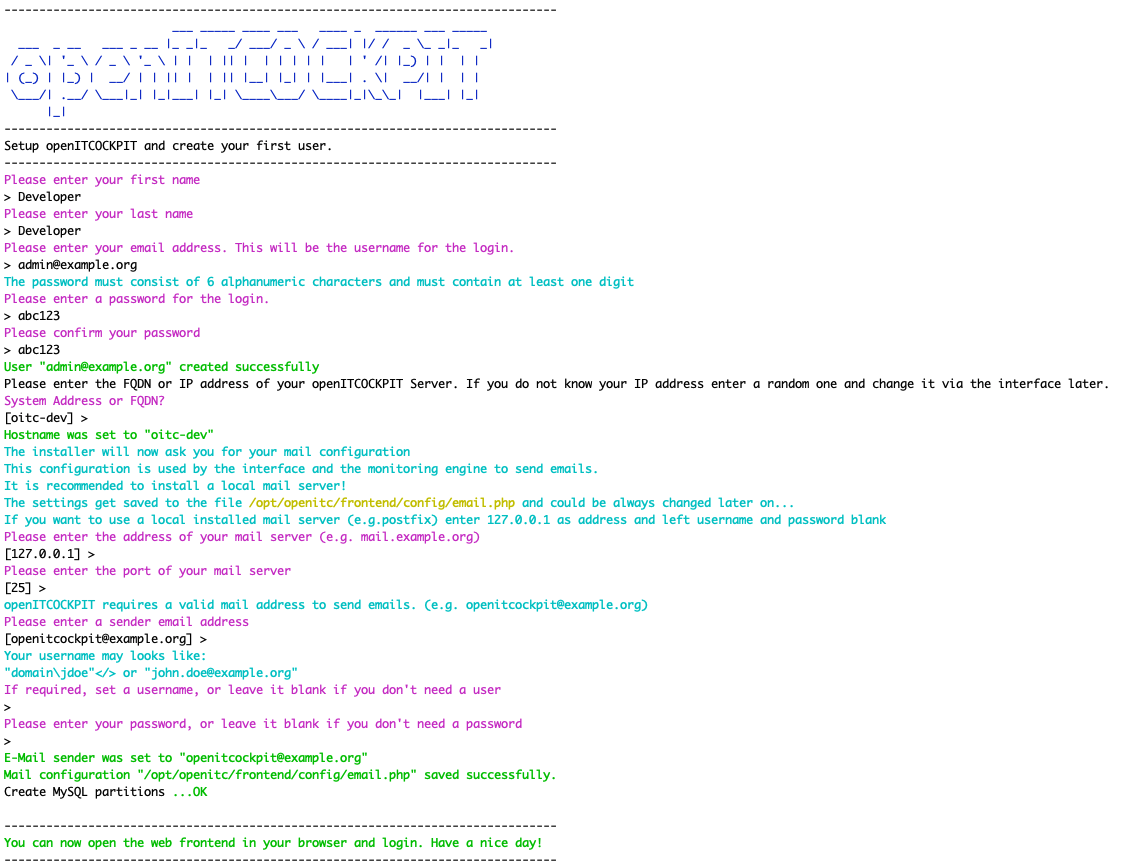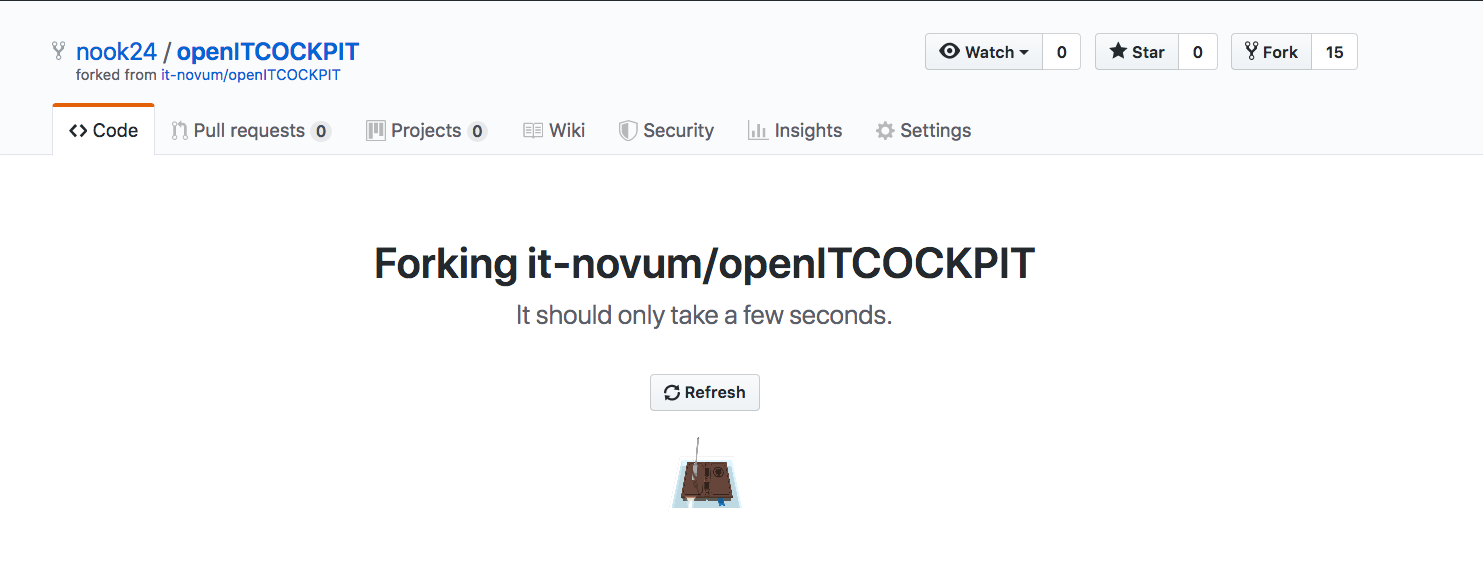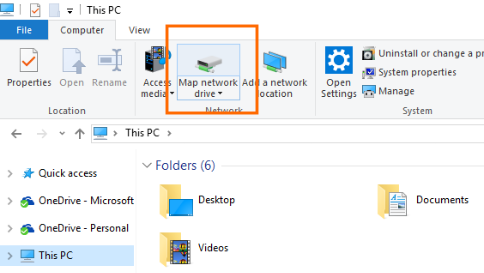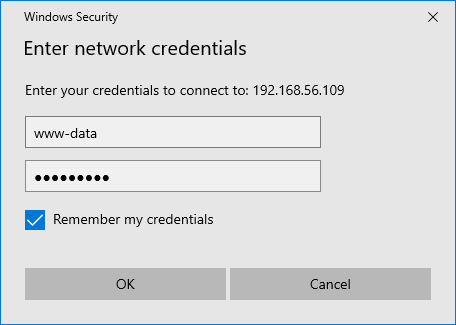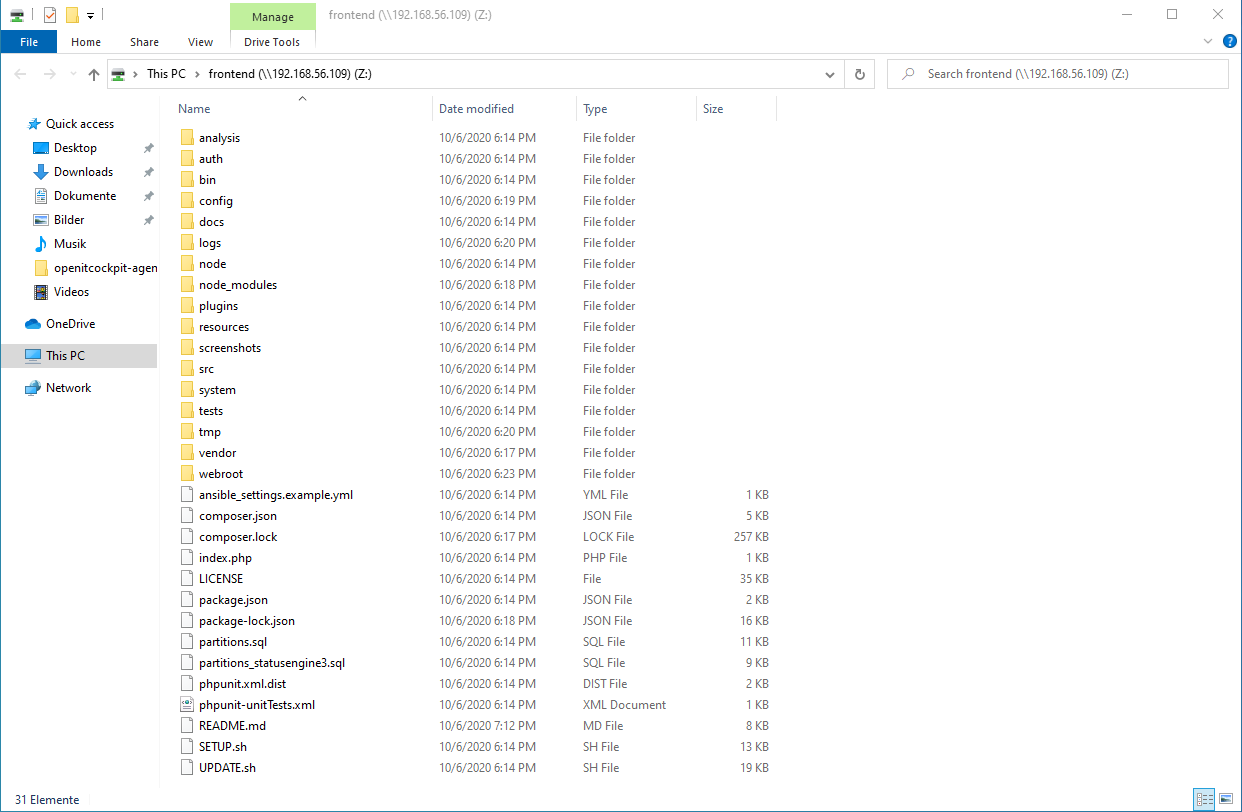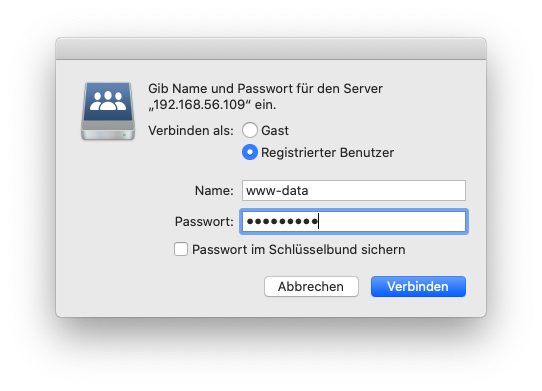Creating an openITCOCKPIT development environment¶
Creating a virtual machine¶
It is recommended you create a new virtual machine (e.g. with VirtualBox) that meets the following minimum requirements:
| OS | Hard disk | RAM | CPU cores |
|---|---|---|---|
| Ubuntu Focal 20.04 (64 Bit) | 20 GB | 2048 MB | 2 |
To be able to reach the machine via the network, select the Bridged Network option under the network settings for the virtual machine.
If you do not want to use a bridged network, we recommend setting up two network cards for the virtual machine. One network card should be in NAT mode to ensure access to the internet and the other in a host-only network to allow the VM to be accessed by your local computer.
For more information on networking with VirtualBox, click on the following link https://www.virtualbox.org/manual/ch06.html
If desired, you can also use "Ubuntu Desktop" to access a graphical user interface.
Preparing the operating system¶
First make sure that the latest updates are installed on your system.
sudo add-apt-repository universe
sudo apt-get update
sudo apt-get dist-upgrade
Installing the required packages for the development environment¶
sudo apt-get dist-upgrade vim git tmux screen mc htop curl wget ca-certificates sysstat nfs-kernel-server samba-common samba gnupg2 apt-transport-https
Enable "root" user¶
By default, the root user is disabled under Ubuntu.
Use sudo to change to the root user.
sudo su
Set a new password for the root user using the command passwd
passwd
Enable the root user to log in via SSH (optional)¶
Open the file /etc/ssh/sshd_config and change the following line:
PermitRootLogin yes
Enable the change:
systemctl restart sshd
You can now log onto the system as root via SSH.
Installing openITCOCKPIT¶
Since you are wanting to install an openITCOCKPIT development environment, we assume that you are familiar with the openITCOCKPIT setup process. For more information on the setup process, please click on the following link: https://openitcockpit.io/download_server/
curl https://packages.openitcockpit.io/repokey.txt | sudo apt-key add -
echo "deb https://packages.openitcockpit.io/openitcockpit/$(lsb_release -sc)/stable $(lsb_release -sc) main" | sudo tee /etc/apt/sources.list.d/openitcockpit.list
sudo apt-get update
sudo apt-get install openitcockpit
Setup openITCOCKPIT¶
Run the openITCOCKPIT Setup Wizard to create a user for the web interface. An actual email address is not required.
sudo /opt/openitc/frontend/SETUP.sh
Setup phpMyAdmin (optional)¶
phpMyAdmin is a web-based MySQL database management tool. After installation, it can be accessed via https://xxx.xxx.xxx.xxx/phpmyadmin erreichbar. The MySQL access data can be found in the file /opt/openitc/etc/mysql/mysql.cnf.
sudo apt-get install phpmyadmin
mysql.cnf Example:
dziegler@oitc-dev:~$ sudo cat /opt/openitc/etc/mysql/mysql.cnf
; Automatically generated for openITCOCKPIT scripts. DO NOT TOUCH!
[client]
database = openitcockpit
host = localhost
user = openitcockpit
password = zw8upknsKte2pGvn
port = 3306
dziegler@oitc-dev:~$
Installing PHP Composer¶
Composer is a package manager for PHP libraries and a prerequisite for an openITCOCKPIT development environment.
curl -o composer-setup.php https://getcomposer.org/installer
php composer-setup.php
sudo cp composer.phar /usr/local/bin/composer
Cloning the GitHub source code¶
openITCOCKPIT uses git as a version control system. The repository is publicly hosted on GitHub.
Forking the openITCOCKPIT repository¶
Although not strictly necessary, it is strongly recommended that you create a personal fork of the official openITCOCKPIT repository.
However, if you want to contribute to the openITCOCKPIT project, this is a prerequisite. If you only intend to look at the source code or you don't have a GitHub account, you can simply clone the official openITCOCKPIT repository.
Cloning your personal repository (recommended)¶
Delete the files that were installed by apt
sudo su
rm -rf /opt/openitc/frontend
Clone the repository (replace YOUR_ACCOUNT_NAME with your GitHub username).
cd /opt/openitc/
git clone -b development https://github.com/YOUR_ACCOUNT_NAME/openITCOCKPIT frontend
Cloning the official openITCOCKPIT repository (only recommended if you do NOT have a GitHub account)¶
Delete the files that were installed by apt
sudo su
rm -rf /opt/openitc/frontend
cd /opt/openitc/
git clone -b development https://github.com/it-novum/openITCOCKPIT frontend
Installing dependencies¶
Make sure that you execute all commands as the root user (sudo su).
Installing the PHP dependencies¶
cd /opt/openitc/frontend
composer install
rm -f /opt/openitc/frontend/config/app_local.php
Installing the JavaScript dependencies¶
cd /opt/openitc/frontend
npm install
Updating the database and repairing the file permissions¶
openitcockpit-update --cc --rights
Activating openITCOCKPIT development mode (permanent)¶
As a developer, you will want to enable the development features of openITCOCKPIT. This will enable, for example, the output of error messages in the browser, the activation of global PHP methods such as dd($var) and debug($var) as well as the loading of uncompressed CSS and JavaScript.
Make sure that you execute all commands as the root user (sudo su).
Danger
Be aware that activating the debug mode can lead to data leaks and the loss of sensitive information.
echo "OITC_DEBUG=1" >> /etc/environment
export OITC_DEBUG=1
sed -i 's/OITC_DEBUG 0/OITC_DEBUG 1/g' /etc/nginx/openitc/master.conf
systemctl restart nginx
Start hacking¶
Accessing files via a remote system (IDE) (optional)¶
Your development environment (e.g. PHPStorm, Visual Studio Code, etc.) will usually not run on the same system as openITCOCKPIT.
There are three common ways to gain access to the source code via your IDE: NFS, SMB and SSH
NFS (Linux and macOS clients)¶
Open the file /etc/exports on your openITCOCKPIT server and create a new entry as follows: (You can enable access for a single IP address or for an entire subnet. Make sure you set the correct IP address for your network).
/opt/openitc/frontend/ 192.168.56.0/24(rw,no_subtree_check,no_root_squash,all_squash,anonuid=33,anongid=33)
sudo exportfs -a
Mounting an NFS share on a Linux client¶
sudo apt-get install nfs-common
mkdir ~/openitcockpit-frontend
mount xxx.xxx.xxx.xxx:/opt/openitc/frontend ~/openitcockpit-frontend
Make sure you replace xxx.xxx.xxx.xxx with the IP address of your openITCOCKPIT server.
You can now open the folder ~/openitcockpit-frontend with your IDE.
Unmounting an NFS share (Linux client)¶
If you no longer need the share on your system, you can remove it with the following command:
umount ~/openitcockpit-frontend
Mounting an NFS share on a macOS client¶
mkdir ~/openitcockpit-frontend
sudo mount_nfs -o resvport xxx.xxx.xxx.xxx:/opt/openitc/frontend ~/openitcockpit-frontend
xxx.xxx.xxx.xxx with the IP address of your openITCOCKPIT server.
You can now open the folder ~/openitcockpit-frontend with your IDE.
Unmounting an NFS share (macOS client)¶
If you no longer need the share on your system, you can remove it with the following command:
sudo umount ~/openitcockpit-frontend
SMB (Windows, Linux und macOS clients)¶
You will first need to set up the SMB daemon on your openITCOCKPIT server.
sudo cp /etc/samba/smb.conf /etc/samba/smb.conf.backup
Replace your current smb configuration, which can be found under /etc/samba/smb.conf, with the following:
[global]
workgroup = WORKGROUP
server string = %h server (Samba, Ubuntu)
#### Debugging/Accounting ####
log file = /var/log/samba/log.%m
max log size = 1000
logging = file
panic action = /usr/share/samba/panic-action %d
####### Authentication #######
server role = standalone server
obey pam restrictions = yes
unix password sync = yes
passwd program = /usr/bin/passwd %u
passwd chat = *Enter\snew\s*\spassword:* %n\n *Retype\snew\s*\spassword:* %n\n *password\supdated\ssuccessfully* .
pam password change = yes
security = user
guest only = yes
map to guest = bad user
guest account = nobody
############ Misc ############
usershare allow guests = yes
#======================= Share Definitions =======================
[frontend]
path = /opt/openitc/frontend
available = yes
browseable = yes
guest ok = no
writeable = yes
create mask = 0644
directory mask = 0755
force user = www-data
valid users = www-data
Set a password for the user www-data to gain access to the files via samba.
smbpasswd -a www-data
Enable the changes:
sudo systemctl restart smbd
Mounting an SMB share on a Windows client¶
- Open Windows Explorer and click on "Connect network drive".
- Add your SMB share as a network drive. Make sure you have selected the option "Establish login using other credentials".
- Use the
www-datauser and password you just set.
- You can now browse the files.
Open Z:\ with your IDE.
Help: https://support.microsoft.com/en-us/help/4026635/windows-10-map-a-network-drive
Mounting an SMB share on a macOS client¶
- Open "Finder" and press
CMD+k.
- Use the
www-datauser and password you just set.
-
- You can now browse the files.
Open /Volumes/frontend with your IDE.
SSH (platform-independent - depends on the IDE)¶
Many IDEs support access to remote files via FTP, SFTP or SSH. The setup process will depend on your IDE. Please search the web for the appropriate SSH setup for your IDE.
Setup for PHPStorm: https://www.jetbrains.com/help/phpstorm/create-new-project-add-remote-server.html
Setup for Visual Studio Code: https://code.visualstudio.com/docs/remote/ssh
